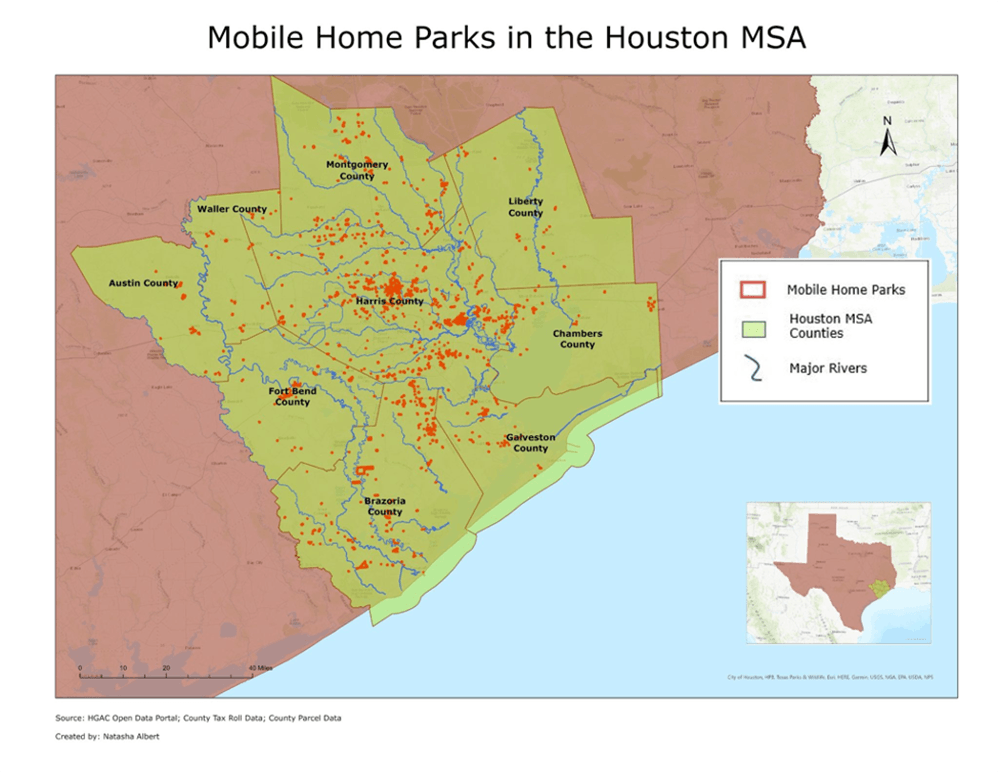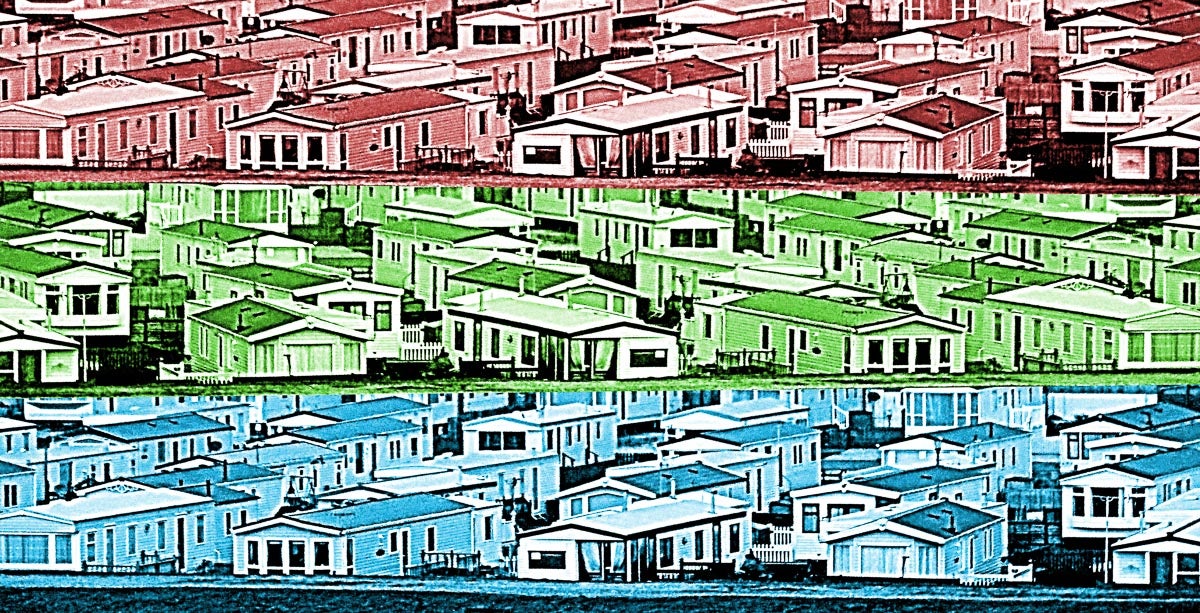A recently published study in the Journal of the American Planning Association has resulted in the first comprehensive mapping and assessment of mobile home park housing in the Greater Houston area. These parks face distinct challenges—its households typically have lower incomes, insecure tenure, less access to transportation and urban amenities and have higher rates of exposure to environmental hazards.
Mobile homes are a major source of housing in the United States. There are over 8.5 million mobile homes (also called manufactured homes and trailer homes) in the U.S., in virtually every state and metropolitan area. Mobile homes are especially prevalent in the Sunbelt region, including Texas, which has 640,875 occupied mobile homes—the most of any state—according to 2019 American Community Survey 1-year estimates. About 17% (109,000) of these are located in the Houston metro area. Mobile homes are popular in part because they are affordable: They cost, on-average, half as much per square foot as conventional single-family homes. In 2011, mobile homes accounted for 50% of new homes sold for under $150,000 in the United States and 71% of new homes under $125,000.
About one-third of mobile homes are placed in mobile home parks (MHPs), which are unique land-lease communities where households own their housing unit but rent the land underneath it. This offers many of the benefits of single-family home neighborhoods at a more affordable price, which appeals to a diverse population. Their affordability, as well as the way they are purchased and financed, also makes them more attainable to a greater number of people than some other forms of affordable housing.
Despite their popularity and contribution to the affordable housing supply, mobile home parks are poorly understood in urban planning research and practice. Our new study published in the Journal of the American Planning Association sheds light on the location, size and regulation of MHPs in metropolitan regions, and focuses on Greater Houston as a case study. In this post, we discuss our research methods and five key findings from our study.
Research design and methods
Our study asks several fundamental questions about mobile home parks in Houston: How are MHPs distributed throughout regional housing markets? What are the socio-demographic and environmental characteristics of places with more MHPs? And how does the location of MHPs relate to local land-use regulations?
We answer these questions by first locating mobile home parks in the Houston metropolitan statistical area, a nine-county area that is the fifth most populous and second fastest-growing metropolitan region in the United States. There is no available inventory of MHPs in Houston or Texas—an important data limitation for researchers and local governments.

We solved this issue using county appraisal district land use records from each of the nine counties in the Houston MSA, which are updated for each parcel every year and are thus more accurate and nuanced than data from other sources (yet still not complete). We imported the land use records into a GIS environment and mapped the individual MHP locations. We then cross-checked those parcels against public and private national datasets and remotely sensed imagery. Comparing these datasets showed none were complete or fully accurate. By combining them, however, along with visual inspection, we were able to develop the most comprehensive and accurate data on MHPs in a metropolitan area.
Next, we collected variables on sociodemographics, housing, measures of access (to transit, jobs, services, and amenities), and environmental exposure for all Census block groups in the Houston MSA. Block groups are the smallest geographical unit for which the Census Bureau publishes sample data (see, for instance, the variables in the American Community Survey). We then compared conditions in block groups to the share of land occupied by MHPs across four groups, from zero MHPs, to low, medium, and high shares of MHPs.
Finally, we created a list of the 132 general-purpose local governments in the Houston MSA and analyzed their land use regulations—comprehensive plans, zoning codes, and mobile home park ordinances. This allowed us to see how these communities are treated within the network of plans and policies that guide each jurisdiction’s development, rather than relying on a single regulation or tool to determine if MHPs were allowed, to what extent, under what conditions, and in which locations.
These analyses produced five important findings:
Mobile home parks are market-rate affordable housing for diverse populations
MHPs are an important piece of the affordable housing system in Greater Houston. We identified 2,185 MHPs in the Houston MSA that contain about 32,000 housing units (Map 2). While we could not directly measure the population in each, our comparison of the Census block groups in the region shows that as the share of land in MHPs increases, the block groups have populations with lower average household incomes, larger households (4+ person), and lower educational attainment. These block groups also have higher shares of Hispanic/Latino households and lower shares of non-Hispanic Black households compared to the region as a whole.
Mobile home parks are concentrated in moderately urbanized areas
MHPs have long been considered “rural housing.” Our study challenges that belief. While MHPs were largely absent from the densest and most highly urbanized parts of the city, they were most prevalent, in moderately urbanized areas closer to the Houston central business district with fewer multi-family apartments. They were also in suburbanized areas near multifamily rental housing, but not near large multi-family buildings (greater than 50 units) or single family detached housing. This means that MHPs are not just a rural housing type; in-fact, they are providing significant amounts of housing in “urban facing” areas outside the core city but within 20 miles of the central business district. This is important because the central areas within regions—central city and first-ring suburbs—often have some of the most severe affordable housing shortages.
Mobile home parks have less access to transportation and urban amenities
Areas of Houston with the largest shares of MHPs have relatively less access to the region’s jobs, less diversity in types of nearby businesses, less walkability, and lower transit connectivity compared to areas with no MHPs—a finding that is consistent with those areas being less urbanized. Yet, the areas with the largest share of MHPs were considerably better-off than outer suburban and exurban areas in-terms of job access and transportation choices. These communities are filling an important housing need in a dynamic regional economy, especially in areas where there are likely fewer affordable housing options, particularly large multifamily apartment buildings.
Mobile home parks have greater exposure to environmental hazards
To measure exposure to environmental hazards, we looked at the block groups in relation to floods and industrial pollution. Here we found that areas with some—but not the most—MHPs have significantly larger shares of land in the 100-year floodplain. For example, block groups with moderate shares of land in MHPs, nearly one-quarter (24.8%) of land is in the mapped 100-year floodplain. This compares to 18.7% of land in block groups with no MHPs and 19% of land in the region overall. However, the share of floodplain land in the block groups with the highest share of MHPs drops to 18.9%, just below the regional average. This is likely because MHPs are concentrated in moderately urbanized places with infrastructure to reduce the size of the floodplain. However, these same block groups with more MHPs have a significantly higher share of land zoned for industrial uses, which is associated with higher exposure to environmental pollutants like airborne particulates and soil contamination.
Mobile home parks are excluded from wealthier, whiter, and incorporated areas
Of the region’s 114 jurisdictions for which there were available land use plans and regulations, 31.5% of jurisdictions prohibit or effectively exclude MHPs. Communities that exclude MHPs through their land-use regulations tend to have significantly higher median incomes, educational attainment levels, housing values, and mean rents and are less racially diverse. Conversely, communities that permit MHPs are less likely to be incorporated, which means the county acts as the local government and may not provide the same level of services as an incorporated municipality. Moving forward, these uneven patterns of land use regulation mean that MHPs will be built (or rebuilt, after disasters) in the places where they already tend to exist, unless those areas have since prohibited their development.
The full study, “Affordable but Marginalized: A Socio-spatial and Regulatory Analysis of Mobile Home Parks in the Houston Metropolitan Area,” can be found in the Journal of the American Planning Association.
Funding Acknowledgement: This material is based upon work supported by the National Science Foundation under Grant No. 1825341.
Further reading by the authors:
Manufactured Insecurity: Mobile Home Parks and Americans’ Tenuous Right to Place, by Esther Sullivan
Mobile Home Parks and Disasters: Understanding Risk to the Third Housing Type in the United States, by Andrew Rumbach, Esther Sullivan and Carrie Makarewicz
Moving Out: Mapping Mobile Home Park Closures to Analyze Spatial Patterns of Low-Income Residential Displacement, by Esther Sullivan
The Contribution of Manufactured Housing to Affordable Housing in the United States, by Noah Durst and Esther Sullivan
Affordable Housing and Disaster Recovery: A Case Study of the 2013 Colorado Floods, by Andrew Rumbach and Carrie Makarewicz
Esther Sullivan is an associate professor of sociology at the University of Colorado Denver. Carrie Makarewicz is an associate professor of urban and regional planning at the University of Colorado Denver. Andrew Rumbach is associate professor of landscape architecture and urban planning and the Director of Education at the Hazard Reduction and Recovery Center at Texas A&M University. Natasha Albert is a master of urban and regional planning candidate at the University of Colorado Denver.

